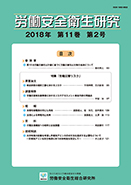Volume 11, Issue 2
Displaying 1-7 of 7 articles from this issue
- |<
- <
- 1
- >
- >|
-
2018Volume 11Issue 2 Pages 83-84
Published: September 28, 2018
Released on J-STAGE: September 28, 2018
Download PDF (143K)
-
2018Volume 11Issue 2 Pages 85-96
Published: September 28, 2018
Released on J-STAGE: September 28, 2018
Advance online publication: March 12, 2018Download PDF (4111K)
-
2018Volume 11Issue 2 Pages 97-107
Published: September 28, 2018
Released on J-STAGE: September 28, 2018
Advance online publication: July 11, 2018Download PDF (2074K)
-
2018Volume 11Issue 2 Pages 109-112
Published: September 28, 2018
Released on J-STAGE: September 28, 2018
Advance online publication: March 23, 2018Download PDF (521K) -
2018Volume 11Issue 2 Pages 113-116
Published: September 28, 2018
Released on J-STAGE: September 28, 2018
Advance online publication: May 15, 2018Download PDF (275K)
-
2018Volume 11Issue 2 Pages 117-120
Published: September 28, 2018
Released on J-STAGE: September 28, 2018
Advance online publication: June 08, 2018Download PDF (461K)
-
2018Volume 11Issue 2 Pages 121-124
Published: September 28, 2018
Released on J-STAGE: September 28, 2018
Advance online publication: May 30, 2018Download PDF (251K)
- |<
- <
- 1
- >
- >|
